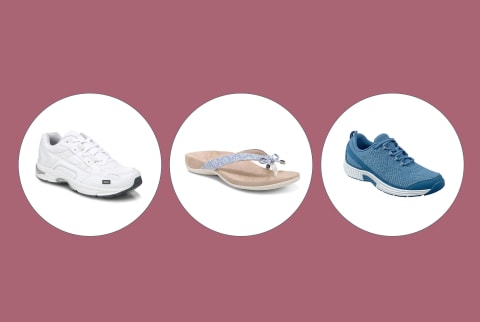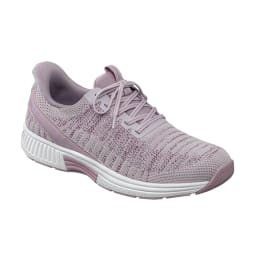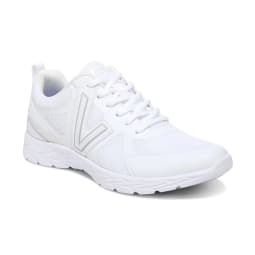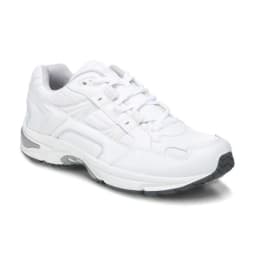Advertisement
Orthofeet vs Vionic: How the Brands Compare + Our Top Picks for Both



- Best for arch support: Orthofeet Coral Stretch Knit
- Best sandals: Vionic Bella Toe Post Sandal
- Best for bunions: Orthofeet Kita
- Best for men: Orthofeet Gemini
- Best for wide feet:Vionic Miles II Sneaker
- Best for walking: Vionic Walker Classic
Shoes that lack the right support or cushion could be putting your foot in an unnatural position1, giving you an off-kilter foundation. This often results in poor posture, sciatic pain, joint and muscle stiffness2, or injury.
What is Orthofeet?
Orthofeet specializes in orthopedic footwear and orthotic inserts designed to provide comfort, support, and pain relief for individuals with various foot conditions, including plantar fasciitis, bunions, arthritis, diabetes, and neuropathy.
With a wide range of shoe styles for men and women, the brand makes athletic shoes, casual shoes, dress shoes, sandals, and slippers.
The designs strike a combination of superior cushioning, arch support, and anatomical shape to enhance stability, alleviate pressure points, and promote proper foot alignment.
Some key features of Orthofeet shoes include extra-depth design to accommodate orthotic inserts and swollen feet, soft interior linings to minimize friction and enhance comfort, and a lightweight construction for reduced fatigue.
One thing we love about the Orthofeet website is the ability to filter by common foot conditions like achilles tendon, back pain, bunions, diabetes, overpronation, heel spurs, and much more.
What’s more, Orthofeet also sells orthotic inserts, which can be used with the brand’s footwear or inserted into other compatible shoes. These inserts are designed to provide arch support, cushioning, and shock absorption for added comfort and foot stability.
What is Vionic?
Vionic is a brand of footwear and orthotic inserts known for its innovative and stylish designs. Vionic offers a variety of shoes for both men and women, including sandals, flats, sneakers, loafers, boots, and slippers.
These shoes are designed to provide comfort and alleviate common foot-related issues such as plantar fasciitis, overpronation, and heel pain.
What sets Vionic apart is the brand's incorporation of biomechanical technology into its footwear. The patented orthotic support system called Orthaheel Technology or Vio-Motion Support provides stability, proper alignment, and cushioning.
Like Orthofeet, Vionic makes orthotic inserts which can be used with any shoes to provide additional support and comfort. The inserts are designed to provide arch support, promote natural foot alignment, and absorb shock.
Orthofeet vs Vionic: Comparing the styles
The specific designs and styles vary between the brands and Vionic is arguably the more stylish option. The brand is known for its contemporary and modern shoes that combine orthotic technology with stylish designs.
Still, Orthofeet is a great option, especially if you experience conditions such as bunions, plantar fasciitis, neuropathy, diabetes, or arthritis.
Orthofeet focuses on creating shoes with a therapeutic and functional design to address specific foot conditions and provide pain relief. The shoes often feature extra-depth design, adjustable features, and soft interior linings to accommodate various foot issues.
Orthoeet vs Vionic: Comparing the technology
Both brands incorporate orthotic technology into their footwear, using different patented support systems.
Orthofeet utilizes an Ortho-Cushioning system with cushioned insoles, contoured orthotic arch support, and ergonomic soles. The brand's focus is on providing cushioning, shock absorption, and support to alleviate foot pain and enhance comfort.
Vionic employs Orthaheel Technology, a biomechanical orthotic system that aims to provide stability, proper alignment, and cushioning to the feet. Vionic's orthotic technology promotes natural foot alignment and provides arche support. Vionic addresses similar foot conditions to Orthofeet, with emphasis on specific conditions such as overpronation, plantar fasciitis, and heel pain.
When it comes to shoes for support and comfort, Vionic is a go-to recommendation from podiatrists. In fact, the brand works with podiatrists to formulate its designs.
Orthofeet vs. Vionic: Our top picks
Pros:
- Optional arch booster & spacer
- Stretchy outer material
- Wide toe box
Cons:
- Stretchy material does not feel durable to some
Sizes available:
5-12 (half sizes available)Colorways:
9 optionsReturn policy:
60 daysThis sneaker is a great choice for people with bunions, swollen feet, or hammertoes. We've even included it in our roundup of the best orthopedic shoes.
The stretchy knitted upper helps these shoes mold to your specific shape—and the arch support is actually customizable. Simply slide a plastic arch booster under the orthopedic insole for a little extra arch support, along with two insole spacers to help you find your perfect fit.
Several people requiring next-level arch support praise these shoes for their cushion and comfort. Others say their foot and knee pain has disappeared since wearing these shoes.
Pros:
- APMA seal of acceptance
- Available in 10 stylish colorways
- Built-in orthotics to prevent back and foot pain
Cons:
- Flip flop style can be uncomfortable for some
Sizes available:
5-12 (some half sizes available)Colorways:
10 optionsReturn policy:
30 daysSandals aren’t always synonymous with comfort or support, but this pick is Vionic's best-selling flip flop for a reason. The supportive, ergonomic design hugs your foot to give you support all day long.
The lightweight midsole provides shock absorption and the footbed is made with microfiber to keep your feet in place.
Many reviewers with pre-existing foot pain say these sandals are comfortable to wear all day long. The only downside is that the light-colored footbed can show wear easily.
Advertisement
Pros:
- Optional arch booster & spacer
- Stretchy outer material for easy slip-on
- Orthotic insoles for heel pain relief
- Standard, wide, and extra wide sizes available
Cons:
- Runs narrow
Sizes available:
5-12 (half sizes available)Colorways:
4 optionsReturn policy:
60 days(varies by retailer)In addition to having a wide toe box that alleviates pressure on swollen feet, bunions, and hammertoes, these sneakers come with orthopedic insoles that offer cloud-like, anatomical arch support, re-align the foot and entire body posture, and alleviate heel and foot pain.
Plus, the soft, stretchy knitted upper molds to your foot shape and eases pressure on bunions. You’d think this high-tech design would result in that cumbersome, orthopedic shoe look, but the sneakers are sleek and minimalist.
Shoppers with bunions and other foot problems rave about these sneakers, noting that they can walk in them all day with no discomfort. Others say the shoes offer great arch support.
Pros:
- Helpful for relieving back pain
- Can add arch support
- Easy on-and-off slide design
Cons:
- Only available in mens
- Only 2 colorways
Sizes available:
7-14 (some half sizes available)StandardWideExtra wideColorways:
2 optionsReturn policy:
60 daysMen with back pain will love this casual shoe you can wear just about anywhere. Its cushioned sole, rocker design, and premium orthotic insoles offer anatomical arch support that realign the foot the posture of your body.
If you need to increase arch support, the brand’s Arch Booster can be added under the insoles for a custom fit.
The shoe’s soft, padded fabric interior is breathable and lightweight, while the soft leather upper moves comfortably with your foot.
Advertisement
Pros:
- Lightweight and breathable
- Generous arch support
- Sleek, stylish design
Cons:
- Not all half sizes available
Sizes available:
5-12 (some half sizes available)StandardWideColorways:
5 optionsReturn policy:
30 daysThis shoe is the next-gen edition of Vionic’s best-selling Miles active sneaker, which we called out in our round-up for the best orthopedic shoes.
The Miles II is a lightweight sneaker offering arch support and extra cushion. It features a removable midsole and an outsole made from a durable rubber.
What's more, the shoe comes with feel-good certifications from the Global Recycled Standard and a seal of acceptance from the American Podiatric Medical Association (APMA).
Many reviews tout the shoe’s superior cushion and support, especially for those with wide feet. On the downside, a couple mention the shoe not holding up so well over extended periods of time. Customer service seemed to respond with solutions, though.
Pros:
- Generous arch support
- American Podiatric Medical Association (APMA) Seal of Acceptance
- Medium & wide widths available
Cons:
- Not machine washable
Sizes available:
5-12 (some half sizes available)Colorways:
12 optionsReturn policy:
30 daysOne of the brand’s best-selling products, the Vionic Walker Classic delivers superb arch support and heel cushioning. The sleek show is designed with premium, full-grain, water repellent leather or suede uppers and an action lacing system.
Those needing custom orthotic inserts will appreciate the shoe’s removable insole with a .5 elevation for extra heel-to-toe alignment.
The shoe’s base features a podiatrist-designed orthotic and the upper is breathable, moisture-wicking, and water-repellant.
Reviewers say the shoe feels sturdy and helps keep them in alignment during long walks or days on their feet.
Advertisement
How we picked:
Purpose
We included shoes for a variety of activities, such as travel, walking, and hiking.
Foot conditions
Some shoes are designed for specific foot conditions, so we made sure to showcase the best options for popular podiatric concerns, like bunions and back pain.
Materials
Both brands offer 30-60 day return policies when the shoes are purchased from their website, so you can discover your new favorite shoe worry-free.
Budget
Everyone’s budget is different, so we made sure to select shoes at a range of price points.
How to choose between Orthofeet and Vionic
Orthotic-friendly: If you have a diagnosed foot condition, look for an orthopedic shoe that can accommodate a custom orthotic if necessary. While both brands accommodate inserts, Orthofeet shoes often feature extra depth, adjustable features, and soft interior linings.
Budget: Orthopedic shoes can get expensive, as can most specialty sneakers, but it's an investment in your health and comfort. Vionic and Orthofeet generally fall into the mid-range to higher-end price range for orthopedic footwear. The shoes are durable and seem to hold up well over time—so look for a design you'll want to get a lot of wear out of.
Style and activity: Both brands have heaps of shoe styles to choose from, including active shoes, sandals, flats, boots, slip-on sneakers, dress shoes and heels, and hiking shoes. Consider your intended use case to help choose the right pick for you.
If you're still not sure which is best for you after looking through our picks, we recommend trying on shoes from both brands and considering your individual needs to determine which brand offers the best fit, comfort, and support.
FAQ:
What are orthopedic shoes?
Orthopedic shoes are designed to support your feet and legs while relieving pain. Many of these shoes can be purchased both from a podiatrist or off the shelf.
How do you know if you need orthopedic shoes?
If you experience chronic foot pain, orthopedic shoes could help. It's best to see a podiatrist for a full diagnosis.
What shoe brand compares to Vionic?
Orthofeet shoes can be compared to Vionic and can even have advantages. They are biomechanically engineered with unique comfort features that are not available in Vionic, though the designs may not always be as stylish.
The takeaway
If you're seeking a pair of orthopedic shoes to promote your overall health, help your posture, and alleviate pain, Orthofeet and Vionic both offer great options. Take a closer look at Orthofeet if you prioritize the gold standard of shoe technology. Or, consider Vionic for ergonomic designs that don’t sacrifice style for comfort. If you're experiencing any concerning foot pain, it's best to see a podiatrist for a diagnosis.
Psst: You should give your house shoes some thought, too. Check out our top picks for the best slippers with arch support.





